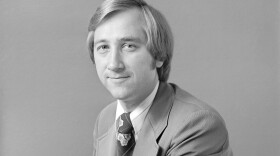Howard Hughes bought it fifty years ago. It closed thirty years ago. Let’s look back at the Silver Slipper.
Last time, we talked about the Silver Slipper. Its good times ended in 1964 when state officials found the house was cheating. But soon it reopened under new ownership: Claudine and Shelby Williams. They brought back the burlesque shows and added boxing. Eventually, they sold the Slipper in 1968 for more than five million dollars. They used the money to buy land across the Strip and opened the Holiday Casino in 1973. After Shelby died in 1977, Claudine became the first woman president and general manager of a Strip property. She sold it to Harrah’s but became board chair and was involved in many important southern Nevada businesses.
The sale of the Slipper was a story in itself. The buyer lived across the street: Howard Hughes. We don’t have to go back through all of the stories about him, but this is one of the more interesting ones: why he bought the Silver Slipper. According to one account, the lights from the neon slipper flashed into the Desert Inn penthouse as it turned. That annoyed Hughes, so he bought the property and got rid of the slipper. Another version has it that he saw the neon slipper’s toe would stop as it faced his room. He feared government or private enemies could spy on him by putting a camera in the toe. Neither one seems likely. But Hughes also tried to buy the Stardust at the same time, and federal authorities expressed anti-trust concerns. The Silver Slipper purchase went forward.
Over the next few years, the Silver Slipper didn’t do that well. It certainly wasn’t the jewel of the Hughes empire. Hughes died in 1976 and his Summa Corporation named a new general manager in 1977 for both the Silver Slipper and another Strip property, the Castaways: Bill Friedman. When he took over, Friedman thought back on his own gambling, studied other properties, and made changes to make the casinos more attractive to customers who just wanted to be at the tables or machines. It worked, and the Slipper became a moneymaker again. Friedman went on to write a book about casino design, and he taught casino management at UNLV (today’s he’s a consultant).
Friedman also took a page from the Slipper’s past. He got rid of the boxing and put in a new showroom with a burlesque show: Boy-lesque, with Kenny Kerr. He emphasized the buffet with a series of television ads with the slogan, “Tomorrow the diet—today the great buffet.”
In 1988, all of that came to an end. Hughes’s heirs were divesting themselves of hotel-casino properties. Their company sold the Silver Slipper for seventy million dollars to Margaret Elardi. She and her family had been involved in the Pioneer Club downtown and the Pioneer Gambling Hall in Laughlin. The new owners tore down the Silver Slipper, supposedly to be rebuilt. It never happened. The spot became a parking lot for Elardi’s Frontier Hotel. It became the scene of the seven-year-old strike by the Culinary Union. After the Frontier’s sale to Phil Ruffin, nothing happened on the Slipper’s land and nothing has yet.
But part of the Silver Slipper is very much with us, and not just because of the legacy and history of people like Claudine Williams and Howard Hughes. In downtown Las Vegas, there’s a neon slipper to remind us of the need to preserve the past, and of our past.








